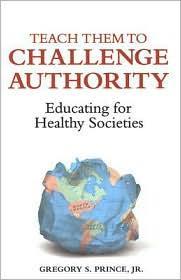
Inside Higher Ed: ‘Teach Them to Challenge Authority’
‘Teach Them to Challenge Authority’
Stanley Fish may be telling academics to keep their opinions to themselves, but Gregory S. Prince Jr. thinks it is time for colleges to stop trying to make their classrooms neutral. Prince, the former president of Hampshire College, argues for professors to take all kinds of positions — as a tool for challenging their students. His new book, Teach Them to Challenge Authority: Educating for Healthy Societies (Continuum) outlines this view, and Prince responded via e-mail to questions about the work.
Q: What’s wrong with a neutral stance in the classroom?
A: A neutral stance in the classroom is appropriate as one of many pedagogical approaches. When it becomes the only pedagogical approach, it deprives students of the chance to learn how to challenge those who have power over them — a skill that is essential in any career, that is essential for the health of any institution and that is critical in a democratic society. Higher education should have been very concerned that at a place like Enron, where almost all of its senior departmental and corporate leadership were college educated, only two at most challenged what was taking place.
Q: You note the criticism that conservatives hurl on liberal academics. Do you think academics have adequately defended themselves?
A: Academics have not adequately defended themselves. Too often they have ignored the critics or taken the position that there is no problem. As the first step in mounting an adequate defense, they should acknowledge that the conservatives are right about the principle that students should not be ridiculed for disagreeing with their professors. They should acknowledge that students should be encouraged to disagree with the politics of their professors. They should acknowledge their responsibility to listen respectfully to opposing points of view and to guide students to sources that support such views.
What happens all too often is that they deny there is a problem rather than challenging the proposed solution to the problem. The problem always will exist because there always will be individuals who cannot or will not master the difficult art of effective teaching. In contrast, I accept that the there are undoubtedly many cases where the critics are right but that to whatever extent the problem exists, the solution that the conservatives propose — having the faculty always maintain a position of neutrality — is the wrong one. Faculty need to take positions so that students can learn how to challenge those in authority. How a faculty member takes a positions is what is critical. It is an art both to take positions and to create an atmosphere in which students will learn how to challenge those positions
Q: What advice would you give to professors who agree with your book, but who teach at institutions where students are more conservative than those at Hampshire?
A: I would give them the same advice that I would give to Hampshire faculty and to faculty in any university. Acknowledge the differences where they exist, listen well to the students, create an atmosphere where they can challenge your positions, respect the students enough to take their positions seriously and be willing to state your own positions and to engage the students in discussion and debate about those positions.
Q: How can you tell if a university is “engaged” in the way you advocate?
A: Universities that test themselves by asking constantly whether they are doing enough and then push themselves to do more are engaged in the way I advocate. What made Hampshire such an exciting place for me was its culture that made asking whether we were doing enough in the classroom, with individual students and with the community outside the college a perpetual part of the educational conversation. Often what we were doing was good, but measured against what was needed, it was rarely good enough. Students are an important part of that conversation because they so often are impatient and feel that so much more can be done. They helped fight complacency that all too often is the greatest danger to delivering a quality educational experience. As a completely different kind of example, land grant institutions, with their explicit service missions that have served this country so well, generally are and have to be, in constant conversations with their legislatures and the public whom they serve about whether “they are doing enough.” Those conversations, difficult as they are sometimes, benefit the academy and the public.
Q: How can presidents protect the freedom of their professors to teach as you suggest — and encourage it?
A: The most effective way is to model in their own behavior what they expect of the faculty, to articulate and practice the principles of discourse that make it possible simultaneously to take positions and to encourage students to challenge those positions and pursue a review and reward system that supports the principles. Confront constructively and fairly and do not ignore those situations where the practices of faculty do not support the core value of the principles of discourse — that what matters is the strength and integrity of one’s argument and rhetoric, not the political hue of the opinion being defended.
— Scott Jaschik
The original story and user comments can be viewed online at http://insidehighered.com/news/2008/09/04/prince.
 Follow
Follow
